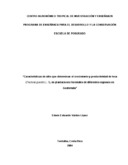| dc.contributor.author | Vaides López, E.E. | |
| dc.date.accessioned | 2014-10-18T03:23:21Z | |
| dc.date.available | 2014-10-18T03:23:21Z | |
| dc.date.issued | 2004 | es_ES |
| dc.identifier | 366626 | es_ES |
| dc.identifier.uri | https://repositorio.catie.ac.cr/handle/11554/4036 | |
| dc.description | Tesis (M. Sc) -- CATIE, Turrialba (Costa Rica),2004 | es_ES |
| dc.description | 81 páginas | |
| dc.description | 25 ilustraciones, 15 tablas | |
| dc.description | 21.59 x 27.94 cm. | |
| dc.description | 44 referencias bibliográficas | |
| dc.description.abstract | Esta investigación se realizó en las regiones forestales II (Las Verapaces), III (Nororiente), VIII (Petén) y IX (Costa Sur) en la república de Guatemala, en plantaciones jóvenes de teca con edades entre 2.6 y 7 años, evaluando un total de 113 Parcelas Permanentes de Monitoreo (PPM), ubicadas en los departamentos de El Petén, Alta Verapaz, Izabal, Zacapa, Suchitepéquez, Retalhuleu y Escuintla. Se evaluaron cuatro clases de sitio para todo el país, basados en el índice de sitio existente para teca a una edad base de 10 años. De igual manera se evaluó la productividad, basada en el incremento medio anual en volumen total. Con este análisis se logró clasificar las plantaciones en cuatro categorías de crecimiento, siendo estos bajo, medio, alto y excelente. Se obtuvieron relaciones importantes entre variables de crecimiento y productividad. También se efectuó una evaluación para generar modelos de predicción de sitio, a partir de variables fisiográficas, climáticas y de suelo. | es_ES |
| dc.description.abstract | This study was conducted in the forest regions II (Las Verapaces), III (Northeast), VIII (Petén) and IX (Southern Coast) in the Republic of Guatemala in young teak plantations between 2.6 and 7 years old. The study evaluated a total of 113 Permanent Monitoring Plots (PMP) located in El Petén, Alta Verapaz, Izabal, Zacapa, Suchitepéquez, Retalhuleu and Escuintla departments. Four site classes in all of the country were evaluated based on the existing site index for 10 year-old teak. Additionally, productivity was evaluated based on the average annual increase and total volume. This analysis classified the plantations into four growth categories: low, medium, high and excellent. Important relationships between growth and productivity variables were obtained. Furthermore, an evaluation was conducted to generate site predictor models using physiographic, climatic and soil variables. | |
| dc.language.iso | es | es_ES |
| dc.publisher | CATIE, Turrialba (Costa Rica) | es_ES |
| dc.subject | FOREST TREES | |
| dc.subject | FOREST PLANTATIONS | |
| dc.subject | GROWTH | |
| dc.subject | DIAMETER INCREMENT | |
| dc.subject | PRODUCTIVITY | |
| dc.subject | SITE FACTORS | |
| dc.subject | SOIL ANALYSIS | |
| dc.subject | PHYSIOGRAPHIC FEATURES | |
| dc.subject | CLIMATEGUATEMALA | |
| dc.subject | TECTONA GRANDIS | |
| dc.subject | ARBOLES FORESTALES | |
| dc.subject | PLANTACION FORESTAL | |
| dc.subject | CRECIMIENTO | |
| dc.subject | INCREMENTO DE DIAMETRO | |
| dc.subject | PRODUCTIVIDAD | |
| dc.subject | CARACTERISTICAS DEL SITIO | |
| dc.subject | ANALISIS DEL SUELO | |
| dc.subject | ASPECTOS FISIOGRAFICOS | |
| dc.subject | CLIMA | |
| dc.title | Características de sitio que determinan el crecimiento y productividad de teca (Tectona grandis L. f.), en plantaciones forestales de diferentes regiones en Guatemala | es_ES |
| dc.title.alternative | Site characteristics that determine teak growth and productivity (Tectona grandis L. F.) in forest plantations in different regions of Guatemala | es_ES |
| dc.type | Tesis de maestría | es_ES |
| dc.identifier.publication | Turrialba (Costa Rica) | es_ES |


